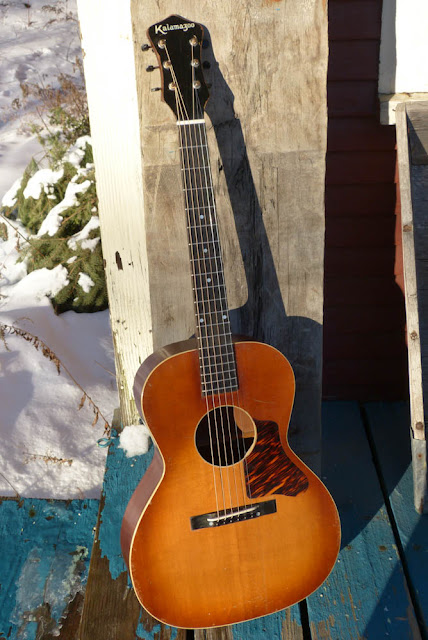1940 Gibson-made Kalamazoo KG-12 (X-Braced) Flattop Guitar
At first glance this looks like a KG-14, but the 1940 factory order number and the "iced-tea" sunburst mark this out as the latter-days variant of that guitar: the KG-12. In addition, this one has some rather peculiar features compared to normal ones including a stained-maple fretboard and bridge (rather than rosewood), poplar (rather than mahogany) neck, and "aftermarket" x-bracing done by the last fellow to work on this before me. The neck also has a "30s style" V-shape rather than the late-30s/early-40s Gibson C-shape that was becoming standard by '39 or so. Aside from the x-bracing and suspicious pearl dots on the bridge, however, the instrument appears as-original. I very much doubt someone would cut a nice Gibson-style bridge of stained-maple or re-board the guitar with a 12" radius (Gibson standard) stained-maple board with standard-issue Gibson frets.
A customer of mine bought this and had me "do it over" which included a neck reset, fret level/dress, some general cleaning-up and drop-fills of old (cleated) hairline crack repairs, and brand new bone compensated saddle and nut. It now plays spot-on and has a great, old-timey sound. To my ears this is what a KG-14 kind-of aspires to sound like: a honkier, more aggressive version of a Gibson L-00 (the latter of which tend to be more lightly-built and fragile -- though more glamorous-sounding -- than their Kalamazoo relations).
Compared to the ladder-braced Kalamazoos, this x-braced one (even in its almost caveman, Kay-style x-bracing) adds more warmth and "sculpt" to the sound overall and can be "overdriven" with heavy picking a lot more sweetly than the ladder-braced versions. The ladder-braced ones, however, have a lot more up-front cut and zing and really suit fingerpicking, country-blues, and slide work.
Nice looks, huh?
There are a couple of old cracks that've been repaired on the top.
Gotta love that "firestripe" pickguard!
Check out that big bone saddle I've got on there! Plenty of room for adjustment over time, now. I "dug" the slot a little deeper into the bridge, too, to help support that tall bit of bone.
The pins are new ebony ones that replaced some icky plastic ones. I'm certain that the pearl dots are non-original but they don't hide any bolts.
The back and sides are still solid mahogany.
The back has had a coat of overspray but doesn't look it at a glance. There's plenty of honest wear-and-tear all over this box.
Here's the "caveman" aftermarket x-bracing. It's straight and thick on the order of 50s Kays that are x-braced, but only has one "flying" brace behind the main x. I think this is the reason it still sounds good: rather than put in a bunch of extraneous finger-bracing coming off the main braces, it just bulks the main ones up and adds mild support for the lower "belly." Kay definitely built in the same way on their 50s x-braced guitars and I always enjoy that sound -- sort of aggressive and loud and gutsy but still warm enough to strum chords.
The difference here is that the guitar that bracing is subject to is a Gibson-built box and thus, of course, it sounds (and plays) even better after work was done.
















Comments